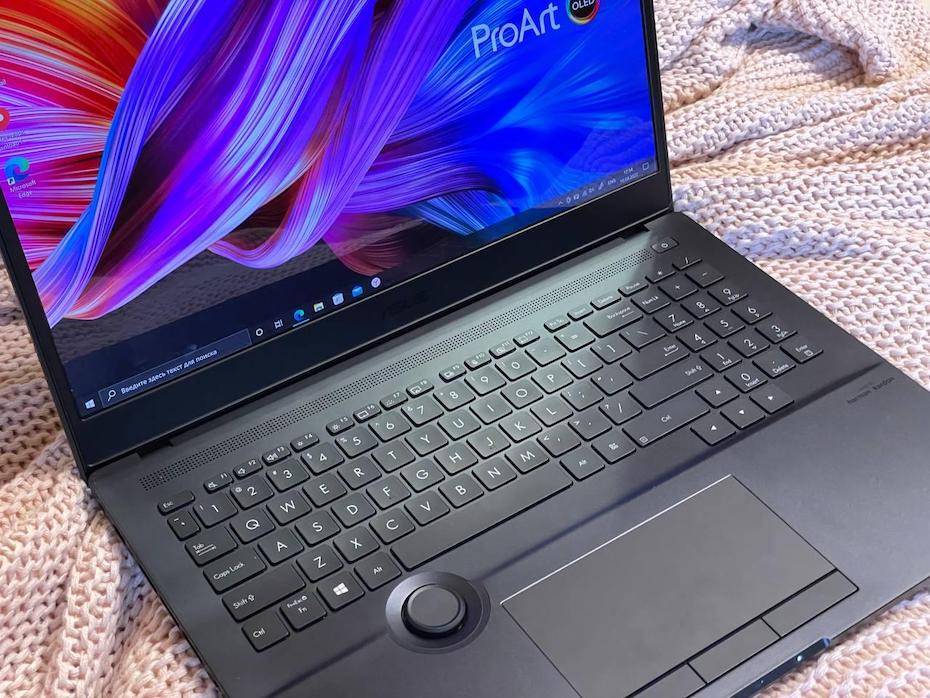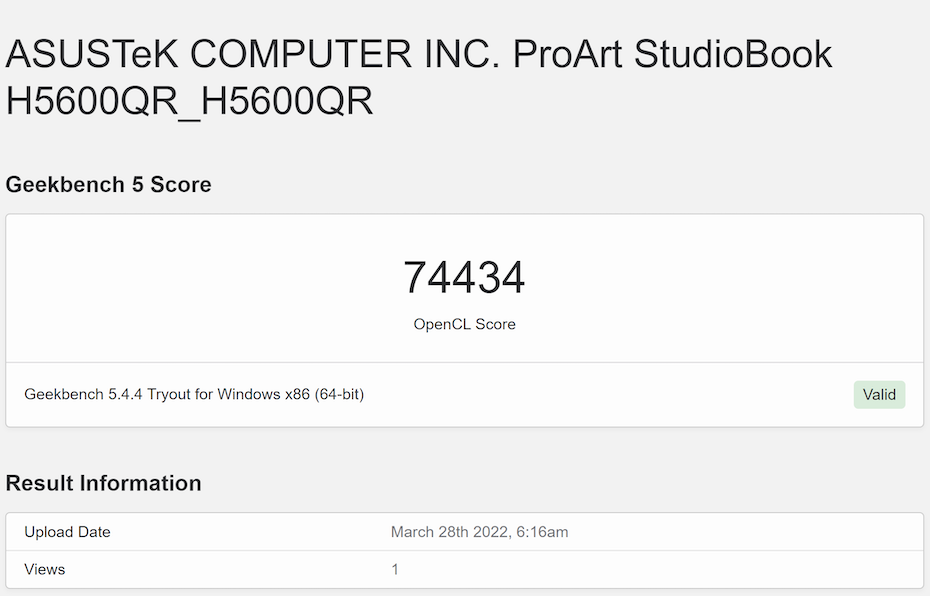In recent years, manufacturers in the gaming laptop segment have made rapid progress and created a number of other types of laptops. For example, the ASUS ROG G14 AW SE Alan Walker Edition is designed for creating and editing music – powerful hardware is combined with high-quality sound.
In addition, powerful laptops are no longer huge and immobile, they are now designed to fit at least in a large travel backpack. In general, initially gaming laptops are becoming universal in terms of hardware, design and application scenarios.
ASUS ProArt Studiobook 16 OLED came to our review. This is the pinnacle of the evolution of VivoBook Pro laptops. Its feature is a full-featured separate ASUS Dial controller. It is not built into the touchpad, but takes a separate place on the device. Let’s see what the laptop is capable of.
Design
The model is aimed at professionals, so the designers did not apply original solutions. This is a black matte laptop with a glossy inscription of the lineup – ProArt.
The laptop is tactilely pleasant – the case does not slip out of the hands. In terms of dimensions, its assessment depends on which device you are switching to it from. If this is a 14-inch ultrabook, this model will seem larger to you. However, even with such experience, it cannot be called huge. If you’re trading from one content creation and editing laptop to another, you’ll be surprised how compact the ProArt Studiobook 16 OLED is.
The laptop is overall, yet it is necessary to fit a 16-inch screen, a discrete graphics card and an effective cooling system into the case. And yet, relative to most models similar to it in terms of power, the ProArt Studiobook 16 OLED surprises with its compactness. For me, it fits in a 15-inch laptop urban backpack. It can be easily taken to the office, coworking, cafe or on the road.
In the open state, the laptop attracts attention with two points at once – the ASUS Dial controller and a physical curtain to close the webcam. The latter increases the level of user privacy – even if you forget to turn off the webcam during a call, it will not capture anything extra if you close it physically. Conveniently.
There is no ErgoLift technology here, so the keyboard sits parallel to the surface on which the laptop rests. For me personally, this is neither a plus nor a minus. I’ve never had problems with the keyboard position, so I don’t see a difference. Globally, in the open state, the laptop is extremely comfortable.
Screen

The laptop display has a diagonal of 16 inches and a resolution of 3840×2400 pixels. The first parameter makes it convenient for creating and editing content – this is convenient to do on a large screen. And the second allows you to get a clear image.
The screen covers 100% of the DCI-P3 palette, which allows it to convey the colors of the image as they were intended by the author. Resolution – 3840 x 2400 pixels, the minimum acceptable for such a diagonal. The image is clear, if you edit videos in Full HD, there will be no complaints about the screen.

On top of all this, the image delay is 0.2ms. This gives it a distinct advantage over a standard 10ms IPS display when playing fast-paced videos. In general, the screen is great for creating, editing and viewing dynamic content with complex editing.
The screen is glossy. On the one hand, matte diffuses glare better and is easier to use on a clear day. On the other hand, the picture on glossy screens seems to be sharper. In addition, at a high level of brightness there will be no problems with light reflection, but here it is in order.
The maximum brightness value is 550 nits. This is decent even for a smartphone, but here we are talking about a laptop. This allows you to comfortably use it even in a room with a high level of lighting.
Keyboard
The keyboard sits parallel to the surface on which the laptop sits, not at an angle. Some users want it to be at an angle, it is more convenient to type, but I do not feel the difference, so this feature is not decisive for me when choosing a laptop.
From the point of view of practical application, the keyboard is classic – with the usual position of the keys and tactile feedback. The key travel is average, the sound is quiet, you will definitely not attract attention with extra sound in a public place like a cafe, and also at night if you work while other people in your apartment are sleeping.
A feature of the laptop is the physical controller DialPad. In the ASUS Vivobook Pro 16X OLED model, it is displayed on the surface of the touchpad for faster execution of various commands in compatible Adobe applications, while the body design allows you to fit a physical instrument here.
For a professional, this is like additional buttons on a controller for a gamer’s console – actions are performed faster, the range of possible commands increases, and there is no need to apply extra efforts for this. For example, using DialPad, you can adjust the screen brightness or system volume without looking up from your current tasks.
It seems to be saving seconds, but this moment has a very positive effect on concentration. In addition, in software for creating and editing content, these parameters are adjusted in separate windows. The presence of DialPad allows you to display others, thereby saving screen space. For example, in Premiere Pro, you can enlarge the windows with video tracks and the image itself. More than 70 commands and actions are available to the controller, including system-wide ones – screen brightness, volume, vertical scrolling.
The touchpad is also interesting. There are three buttons here instead of two, as is usually the case. They duplicate mouse buttons. Instead of buttons, you can also use a double tap on the touchpad.
Iron

The laptop is equipped with a processor up to AMD Ryzen 9 5900HX and a GeForce RTX 3070 graphics card, depending on the configuration. We have a version with exactly these parameters. The combination of these components allows you to perform the most resource-intensive tasks from gaming to 3D modeling.
The advantage of the Vivobook Pro 16X OLED is memory. Depending on the configuration, the amount of RAM is up to 64 GB, and the storage capacity is up to 4 TB. We got the version with 32 GB of RAM and 2 TB of storage. This amount of RAM allows you to simultaneously run two resource-intensive applications. For example, a video editor and Google Chrome to find the files you need. In the process, no application lags; when playing the mounted file in the editor, there is no image delay.

In the benchmark, the laptop scores 74,734 points. By comparison, the 2019 MacBook Pro 16 (Apple’s latest 16-inch Geekbench laptop) scores 32,782. The technical potential of the laptop from ASUS is twice as high. It is also ahead of its fellow ASUS Vivobook Pro 16X OLED with the same processor, but a simpler graphics card and, as a result, 51,671 points.
Another plus of laptop hardware is the cooling system. Here is the IceCool Pro system. It uses seven intelligent sensors, six heat pipes and two fans with a record number of blades – 102 each. In high-speed mode, it allows you to increase the total thermal package of the CPU and GPU up to 135 W (45 W and 90 W, respectively) – without performance degradation due to throttling.
Characteristics
- Processor – AMD Ryzen 9 5900HX
- Video Processor – NVIDIA GeForce RTX 3070
- Operating system – Microsoft Windows 10
- RAM – 32GB DDR4 @ 3200MHz (Maximum 64GB DDR4-3200)
- Storage – 1TB Gen3 x4 SSD M.2
- Screen – 16″ 4K OLED (3840 x 2400) 16:10 non-touch, glossy, 400 cd/m2, 100% DCI-P3, color accuracy ?E < 2
- Relative screen area – 85%
- Wireless interfaces – Wi-Fi 6 (802.11 ax); Bluetooth v5.0
- Battery – 4 cells, Li-ion, 90 Wh
- Dimensions – 362 x 264 x 19.9mm
- Weight – 2.4 kg
Outcome

ASUS ProArt Studiobook 16 OLED is a handy laptop for creating and editing content. Its keyboard with a physical controller allows you to use more commands than the average laptop, and powerful hardware to solve the most complex tasks, up to 3D modeling.
In addition to all of the above, the laptop has an ergonomic body, given its screen size and power. In general, power, convenience and style in one case.
The post Revolution among professional laptops? Pros and cons of ASUS ProArt Studiobook 16 OLED, after which laptops will not be the same appeared first on Gamingsym.






